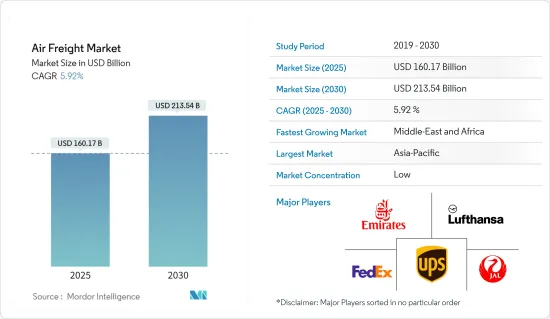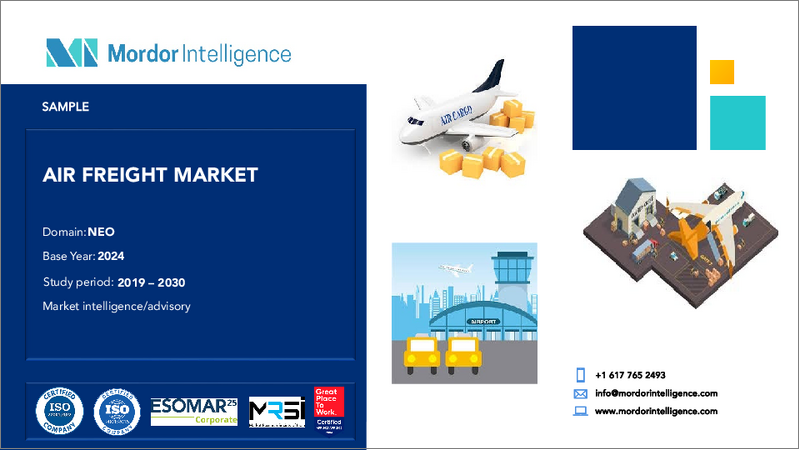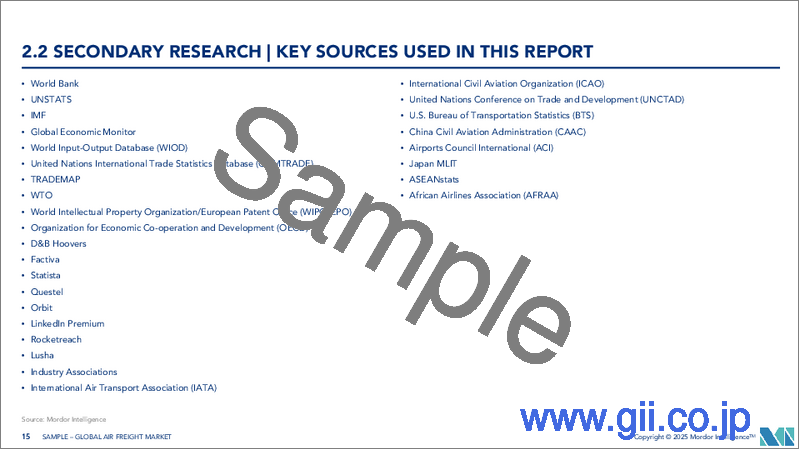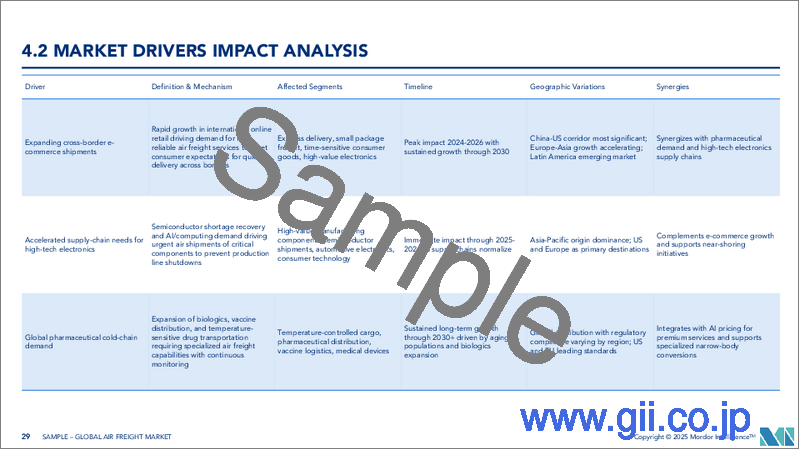|
|
市場調査レポート
商品コード
1685864
航空貨物- 市場シェア分析、産業動向・統計、成長予測(2025年~2030年)Air Freight - Market Share Analysis, Industry Trends & Statistics, Growth Forecasts (2025 - 2030) |
||||||
カスタマイズ可能
適宜更新あり
|
|||||||
| 航空貨物- 市場シェア分析、産業動向・統計、成長予測(2025年~2030年) |
|
出版日: 2025年03月18日
発行: Mordor Intelligence
ページ情報: 英文 250 Pages
納期: 2~3営業日
|
全表示
- 概要
- 目次
航空貨物市場規模は2025年に1,601億7,000万米ドルと推計され、予測期間中(2025年~2030年)のCAGRは5.92%で、2030年には2,135億4,000万米ドルに達すると予測されます。

航空貨物業界は2022年にかなりの課題に直面したが、これは主にロシアとウクライナの間で紛争が続いており、ロシア発の専用航空貨物量が大幅に減少しているためです。
国際航空運送協会によると、2023年7月の航空貨物業界は前月比20.7%増となり、2023年2月以来着実な成長を維持しています。しかし、2022年7月と比較すると、業界の貨物トンキロ(CTK)は0.8%減少し、2022年7月のレベルを0.3%下回り、2019年の危機前のレベルを3.7%下回りました。
航空会社は、パンデミックという歴史的な衝撃の中で、目覚ましい革新性と機敏性を発揮し、この間の回復力を示しました。航空会社の財務的収益性は、マクロ経済環境によるコスト進化の圧力が続いているにもかかわらず、業界全体としては手の届く範囲にあります。他のセクターとは異なり、ジェット燃料価格と原油価格の間の大幅なギャップは、航空会社が潜在的な原油価格の下落から利益を得る能力を制限しています。製油所の能力が限られているため、2023年まで問題が続きます。賃金上昇に直結する労働市場の逼迫と、川下の航空バリュー・チェーンにおける持続不可能な価格決定力は、2023年も続く可能性が高いです。
このバージョンは、元の文脈と情報を維持しながら、より良い流れを作るために、いくつかの文章を分解し、特定の部分を言い換えることにより、読みやすさを向上させることを目的としています。
航空貨物市場の動向
航空貨物市場の需要拡大
航空貨物産業は世界貿易を支える基幹産業であり、商品の輸送を促進し、世界中の企業を相互接続しています。近年、世界経済の成長、消費者の嗜好の進化、技術の進歩により、航空貨物が劇的に急増しています。国境を越えた貿易が現在の市場成長の主な原動力となっており、今後数年でさらに加速すると予想されていまセンす。世界貿易の拡大に伴い、迅速かつ効率的な国際海運への需要が高まっています。
2023年8月、中国の深セン宝安国際空港(SBI)は、1月から7月にかけて、越境eコマースが2倍に増加しました。SBIは、7ヶ月間で9万3,000トンの国際eコマースの取り扱いに成功し、昨年比101%の伸びを記録しました。
提携航空会社のセントラル航空とユンエクスプレスは、7月下旬に2便目のボーイング777貨物便を導入しました。この貨物機の増便は、深センとパリを結ぶフライトを週3便から週6便に拡大することを目的としています。
2023年4月、デジタル航空貨物マーケットプレースに新機能が導入され、輸入を管理する物流会社が他国の代理店から輸出貨物を迅速に予約できるようになりました。この開発により、これまで電話やEメールで見積もりを取っていた時間のかかるプロセスが不要になります。
Cargo.Oneは、パートナーとの海外ブッキングを求める貨物フォワーダー向けに、ブッキングの実行に第三者を必要としない、より簡単なブッキングをターゲットとしたアップグレードを発表しました。
Freightos社の一部であるWebCargo社は、中国の航空貨物卸売販売業者が、航空会社のパートナーのように、貨物代理店に直接スペースを販売できるようになったことを明らかにしました。
CargoAiに代表されるサードパーティプラットフォームは、航空会社のキャパシティを統一されたプラットフォームで販売することを可能にし、フォワーダーは、KayakやPricelineのようなプラットフォームを使用してオンラインで航空座席、ホテル、レンタカーを購入する旅行者と同様に、貨物を電子的に予約しながら、ライブレートと空室状況を比較することができます。
eコマースの成長が航空貨物業界に大きな機会をもたらす
パンデミック時のeコマースの爆発的な急増は、その将来的な軌道を予測不可能なものにしました。世界中の消費者がデジタル取引の利便性を受け入れているため、このオンラインショッピング現象は世界の常識となっています。IATAによれば、国際eコマースの80%が航空輸送に依存しており、効率性、安全性、透明性の向上により、国境を越えたショッピングが大幅に合理化されています。予測では、eコマース部門の大幅な拡大が見込まれており、2026年までに4兆4,000億米ドルに達する可能性があります。
ロジスティクス、モバイル機器の普及、マーケットプレースの拡大が、この予想成長に拍車をかける極めて重要な要因です。さらに、この拡大は新たな地域だけにとどまらず、オンライン・ショッピングがすでに定着している地域にも及んでおり、ロジスティクスの重要な役割が浮き彫りになっています。航空貨物業界は、世界なネットワーク、適応可能なキャパシティ、デジタル化のイニシアチブを誇り、eコマースの成長を強化するのに十分な態勢を整えています。これらの取り組みは、輸送中の業務効率と貨物の可視性を高めることを約束するものです。
世界のeコマースの急成長に伴い、戦略的パートナーシップ、最先端技術、堅牢なインフラが航空貨物分野を支配し、各旅程段階での可視性、柔軟性、迅速性が確保されるでしょう。デルタ・カーゴは2024年2月、SmartKargoと共同開発した新商品「DeliverDirect」を発表しました。顧客が好みを変更できるようにする様々なサービス革新により、DeliverDirectのオファーは荷送人の特定のニーズを満たすことができます。
航空貨物業界の概要
航空貨物業界は適度に断片化されており、支配的な企業が世界の複数の地域で事業を展開しています。航空貨物輸送サービスに対する需要の増加は、貨物プロバイダーに新たな課題を提示しています。航空会社は、費用対効果の高いサービスを提供するために、燃料効率の高いソリューションを導入し、革新的な技術を取り入れることを優先しなければならないです。
例えば、ルフトハンザ・カーゴのような企業は、eブッキング・システムなどのデジタル機能に投資しており、アプリケーション・プログラミング・インターフェース(API)を通じてブッキング・システムにアクセスできるようにし、在庫へのアクセス性を提供することを目指しています。
しかし、規制紛争(米国と中国の貿易戦争など)、反国家的活動、COVID-19パンデミックは、航空貨物業界を大きく混乱させました。この混乱により、安全上の懸念から多数のフライトがキャンセルされ、旅客数が減少しました。
空港を通じて輸送される貨物の倉庫要件をサポートするため、経済特区(SEZ)、自由貿易区(FTZ)、保税倉庫が重要な役割を果たすことが期待されています。
その他の特典:
- エクセル形式の市場予測(ME)シート
- 3ヶ月間のアナリスト・サポート
目次
第1章 イントロダクション
- 調査の成果
- 調査の前提
- 調査範囲
第2章 調査手法
第3章 エグゼクティブサマリー
第4章 市場洞察
- 市場概要
- 業界の規制と政策
- 技術スナップショットとデジタル動向
- バリューチェーン/サプライチェーン分析
- 航空貨物運賃の詳細
- 航空貨物産業における重量貨物/プロジェクトロジスティクスのスポットライト
- 空港における主要グランドハンドリング機器に関する洞察
- 危険物の安全輸送に関する基準と規制のレビューと解説
- 航空貨物部門におけるコールドチェーン・ロジスティクスの概要
第5章 市場力学
- 市場促進要因
- 世界貿易の増加
- eコマースの成長
- 市場抑制要因
- 高い運用コスト
- 生産能力の制約
- 市場機会
- 生鮮品需要の増加
- 世界における新市場の出現
- 業界の魅力- ポーターのファイブフォース分析
- 新規参入業者の脅威
- 買い手/消費者の交渉力
- 供給企業の交渉力
- 代替品の脅威
- 競争企業間の敵対関係の強さ
第6章 市場セグメンテーション
- サービス別
- フォワーディング
- 航空会社
- 郵便
- 仕向地別
- 国内
- 国際線
- 航空会社タイプ別
- ベリーカーゴ
- 貨物船
- 地域別
- アジア太平洋
- 中国
- 日本
- インド
- 韓国
- その他のアジア太平洋
- 北米
- 米国
- カナダ
- 欧州
- 英国
- ドイツ
- フランス
- ロシア
- その他の欧州
- 中東・アフリカ
- サウジアラビア
- アラブ首長国連邦
- カタール
- 南アフリカ
- その他の中東・アフリカ
- ラテンアメリカ
- ブラジル
- メキシコ
- アルゼンチン
- コロンビア
- その他のラテンアメリカ
- アジア太平洋
第7章 競合情勢
- 市場集中度の概要
- 企業プロファイル
- FedEx(Federal Express)Corporation
- The Emirates Group
- Cathay Pacific Airways Limited
- Cargolux Airlines International SA
- China Airlines Ltd
- Japan Airlines Co. Ltd
- Qatar Airways Company QCSC
- Deutsche Lufthansa AG
- All Nippon Airways Co. Ltd(ANA)
- International Consolidated Airlines Group SA
- Magma Aviation Limited
- Deutsche Post DHL
- United Airlines
- American Airlines
- Delta Airlines
- Gol Airlines
- Azul Airlines
- LATAM Airlines
- Copa Airlines
- AirBridgeCargo Airlines
- Cargojet Inc.*
- その他の企業
第8章 市場機会と今後の動向
第9章 付録
- マクロ経済指標(GDP分布、活動別、運輸・倉庫業の経済への寄与度)
- 対外貿易統計-輸出と輸入(製品別)
- 主要輸出先および輸入原産国に関する洞察
The Air Freight Market size is estimated at USD 160.17 billion in 2025, and is expected to reach USD 213.54 billion by 2030, at a CAGR of 5.92% during the forecast period (2025-2030).

The air cargo industry faced considerable challenges in 2022, mainly due to the ongoing dispute between Russia and Ukraine, significantly reducing the volume of dedicated air cargo originating in Russia.
According to the International Air Transport Association, in July 2023, the air cargo industry experienced a 20.7% increase from the previous month, maintaining steady growth since February 2023. However, compared to July 2022, the industry's cargo tonne kilometers (CTKs) decreased by 0.8%, placing it 0.3% below the July 2022 level and 3.7% lower than the pre-crisis level in 2019.
Airlines demonstrated remarkable innovation and agility throughout the historical shock of the pandemic, displaying resilience during this period. The financial profitability of airlines is within reach of the industry at large despite continued pressure on cost evolution from the macroeconomic environment. Unlike other sectors, the substantial gap between jet fuel and oil prices limits airlines' ability to benefit from potential oil price declines. There was a persistent problem until 2023 due to the limited capacity of refineries. Tight labor markets direct to higher wages and unsustainable pricing power within the downstream aviation value chain were likely to persist in 2023.
This version aims to enhance readability by breaking down some sentences and rephrasing certain parts for better flow while maintaining the original context and information.
Air Freight Market Trends
Growing Demand For The Air Freight Market
The air cargo industry is the backbone of global trade, facilitating the transportation of goods and interconnecting companies worldwide. In recent years, there has been a dramatic surge in air cargo due to the growth of the global economy, evolving consumer preferences, and technological advancements. Cross-border trade is the primary driver behind the current market growth, which is expected to accelerate further in the coming years. The demand for swift and efficient international shipping intensifies as global trade escalates.
In August 2023, China's Shenzhen Bao'an International Airport (SBI) experienced a twofold increase in cross-border e-commerce from January to July, anticipating further growth in the remaining five months after including freighter flights in the airport's operations. SBI successfully managed 93,000 tons of international e-commerce in seven months, marking a 101% increase compared to last year.
Partner airlines Central Airlines and YunExpress introduced a second Boeing 777 freight flight in late July, a move anticipated to bolster cargo volumes significantly. This additional freighter aims to expand the airlines' service from three to six weekly flights connecting Shenzhen and Paris.
April 2023 witnessed the introduction of new features in digital air cargo marketplaces, allowing logistics companies overseeing imports to promptly book export shipments from agents in other countries. This development eliminates the previously time-consuming process of sourcing quotes via phone or email.
Cargo.One announced an upgrade targeting easier booking for freight forwarders seeking overseas bookings with partners, eliminating the need for a third party to execute the booking.
WebCargo, a part of the Freightos companies, disclosed that air freight wholesale distributors in China can now sell space directly to freight agents, akin to airline partners.
Third-party platforms, exemplified by CargoAi, enable airlines to vend their capacity in a unified platform, empowering forwarders to compare live rates and availability while electronically booking shipments, similar to how travelers shop for air seats, hotels, and rental cars online using platforms like Kayak and Priceline.
E-commerce Growth Creating Great Opportunities For The Air Freight Industry
The explosive surge of e-commerce during the pandemic rendered its future trajectory unpredictable. This online shopping phenomenon has become a global norm as consumers worldwide embrace the convenience of digital transactions. IATA reports that 80% of international e-commerce relies on air transport, significantly streamlining cross-border shopping with enhanced efficiency, security, and transparency. Projections anticipate a substantial expansion in the e-commerce sector, potentially soaring to USD 4.4 trillion by 2026.
Logistics, widespread mobile device ownership, and marketplace expansions are pivotal factors that fuel this anticipated growth. Moreover, this expansion is not confined solely to new regions but encompasses areas where online shopping has already entrenched itself, underscoring the crucial role of logistics. The air cargo industry, boasting global networks, adaptable capacity, and digitalization initiatives, stands well-equipped to bolster e-commerce growth. These initiatives promise to augment operational efficiency and shipment visibility throughout transit.
As the global e-commerce landscape burgeons, strategic partnerships, cutting-edge technologies, and robust infrastructures will dominate the air cargo arena, ensuring visibility, flexibility, and swiftness at each journey stage. Delta Cargo announced in February 2024 that it launched a new product called DeliverDirect, developed jointly with SmartKargo. With various service innovations enabling customers to modify their preferences, the DeliverDirect offer can meet shippers' specific needs.
Air Freight Industry Overview
The air freight industry is moderately fragmented, with dominant players operating across multiple regions worldwide. The increasing demand for air freight transportation services presents new challenges to cargo providers. Airlines must prioritize implementing fuel-efficient solutions and embracing innovative technologies to offer cost-effective services.
For instance, companies like Lufthansa Cargo have invested in digital capabilities, such as their e-booking system, and aim to make their booking systems accessible through Application Programming Interfaces (APIs), providing inventory accessibility to others.
However, regulatory disputes (such as the US-China trade war), anti-national activities, and the COVID-19 pandemic significantly disrupted the air freight industry. This disruption led to the cancellation of numerous flights due to safety concerns and a decrease in passenger numbers.
To support the warehousing requirements of goods transported through airports, special economic zones (SEZs), free trade zones (FTZs), and bonded warehouses are expected to play a crucial role.
Additional Benefits:
- The market estimate (ME) sheet in Excel format
- 3 months of analyst support
TABLE OF CONTENTS
1 INTRODUCTION
- 1.1 Study Deliverables
- 1.2 Study Assumptions
- 1.3 Scope of the Study
2 RESEARCH METHODOLOGY
3 EXECUTIVE SUMMARY
4 MARKET INSIGHTS
- 4.1 Market Overview
- 4.2 Industry Policies and Regulations
- 4.3 Technology Snapshot and Digital Trends
- 4.4 Value Chain / Supply Chain Analysis
- 4.5 Elaboration on Air Freight Rates
- 4.6 Spotlight on Heavy Cargo/Project Logistics in the Air Cargo Industry
- 4.7 Insights into Key Ground Handling Equipment in Airports
- 4.8 Review and Commentary on Standards and Regulations on the Safe Transport of Dangerous Goods
- 4.9 Brief on Cold Chain Logistics in the Air Cargo Sector
5 MARKET DYNAMICS
- 5.1 Market Drivers
- 5.1.1 Increasing Global Trade
- 5.1.2 Growth of E-commerce
- 5.2 Market Restraints
- 5.2.1 High Operational Costs
- 5.2.2 Capacity Constraints
- 5.3 Market Opportunities
- 5.3.1 Increasing Demand for Perishable Goods
- 5.3.2 The Emergence of New Markets on the Globe
- 5.4 Industry Attractiveness - Porter's Five Forces Analysis
- 5.4.1 Threat of New Entrants
- 5.4.2 Bargaining Power of Buyers/Consumers
- 5.4.3 Bargaining Power of Suppliers
- 5.4.4 Threat of Substitute Products
- 5.4.5 Intensity of Competitive Rivalry
6 MARKET SEGMENTATION
- 6.1 By Service
- 6.1.1 Forwarding
- 6.1.2 Airlines
- 6.1.3 Mail
- 6.2 By Destination
- 6.2.1 Domestic
- 6.2.2 International
- 6.3 By Carrier Type
- 6.3.1 Belly Cargo
- 6.3.2 Freighter
- 6.4 By Geography
- 6.4.1 Asia-Pacific
- 6.4.1.1 China
- 6.4.1.2 Japan
- 6.4.1.3 India
- 6.4.1.4 South Korea
- 6.4.1.5 Rest of Asia-Pacific
- 6.4.2 North America
- 6.4.2.1 United States
- 6.4.2.2 Canada
- 6.4.3 Europe
- 6.4.3.1 United Kingdom
- 6.4.3.2 Germany
- 6.4.3.3 France
- 6.4.3.4 Russia
- 6.4.3.5 Rest of Europe
- 6.4.4 Middle East and Africa
- 6.4.4.1 Saudi Arabia
- 6.4.4.2 United Arab Emirates
- 6.4.4.3 Qatar
- 6.4.4.4 South Africa
- 6.4.4.5 Rest of Middle East and Africa
- 6.4.5 Latin America
- 6.4.5.1 Brazil
- 6.4.5.2 Mexico
- 6.4.5.3 Argentina
- 6.4.5.4 Colombia
- 6.4.5.5 Rest of Latin America
- 6.4.1 Asia-Pacific
7 COMPETITIVE LANDSCAPE
- 7.1 Market Concentration Overview
- 7.2 Company Profiles
- 7.2.1 FedEx (Federal Express) Corporation
- 7.2.2 The Emirates Group
- 7.2.3 Cathay Pacific Airways Limited
- 7.2.4 Cargolux Airlines International SA
- 7.2.5 China Airlines Ltd
- 7.2.6 Japan Airlines Co. Ltd
- 7.2.7 Qatar Airways Company QCSC
- 7.2.8 Deutsche Lufthansa AG
- 7.2.9 All Nippon Airways Co. Ltd (ANA)
- 7.2.10 International Consolidated Airlines Group SA
- 7.2.11 Magma Aviation Limited
- 7.2.12 Deutsche Post DHL
- 7.2.13 United Airlines
- 7.2.14 American Airlines
- 7.2.15 Delta Airlines
- 7.2.16 Gol Airlines
- 7.2.17 Azul Airlines
- 7.2.18 LATAM Airlines
- 7.2.19 Copa Airlines
- 7.2.20 AirBridgeCargo Airlines
- 7.2.21 Cargojet Inc.*
- 7.3 Other Companies
8 MARKET OPPORTUNITIES AND FUTURE TRENDS
9 APPENDIX
- 9.1 Macroeconomic Indicators (GDP Distribution, by Activity, Contribution of the Transport and Storage Sector to Economy)
- 9.2 External Trade Statistics - Exports and Imports, by Product
- 9.3 Insights into the Key Export Destinations and Import Origin Countries





